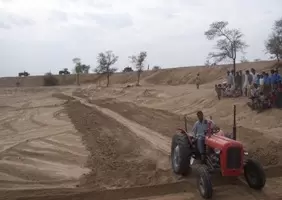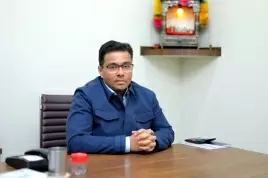By forming a ‘Jal Sabha’, Rajasthani villagers are making efforts to harvest rainwater

06-July-2012
Vol 3 | Issue 27
Residents of two villages surrounded by deserts in Rajasthan's Barmer district are toiling hard day and night, digging up water storage facilities like ponds and step-wells to improve their water-retaining capacity.
Thob and Rewada, the two villages, are about 550 kilometers from state capital Jaipur.
.webp) |
|
Water is scarce in Barmer district and traditional water storage facilities are a lifeline to the people (Photos: Jal Bhagirathi)
|
Villagers have vowed not to waste a single drop of water this monsoon.
"Hardly anyone would be able to understand the importance of water better than us. Traditional water storage facilities are a lifeline for us. So it is very important to maintain them properly. That's why we have launched a campaign to clean them and improve their water storage capacity," said Ramkishore, a local resident.
"We are working these days on Ganwai pond situated on the border of Thob and Rewada villages. It is a huge pond and a lifeline for about 2,000 residents of these two villages. However, it was not storing water to its fullest capacity for some years because of silt and garbage gathered inside it," he said.
Two-third of the state's geographical area is a part of the Great Thar Desert. Primarily Barmer district is a desert where the average rain fall in a year is 277 mm.
These villagers are being aided by some non-government organisations (NGOs) including Jodhpur based Jal Bhagirathi.
The residents of these two villagers have formed a 'Jal Sabha', a self-run body for the management of Ganwai pond.
"Meetings of the body are held on regular basis. Its job is to come up with ideas for improving pond's storage capacity," said M.S. Rajpurohit a resident of Thob.
 |
To make the Jal Sabha self independent financially, Rs.100 is charged for every tanker which takes water from the pond. This money is used in the pond's upkeep.
"We charge money from these water tankers only to maintain our precious water resources," said Rajpurohit.
Rajasthan is the largest state of India but a dry one. The state has more than 10.4 percent of the country's geographical area.
It supports more than 5.5 percent of the country's population and 18.70 percent of the livestock but only has 1.16 percent of the total surface water available. - IANS
















